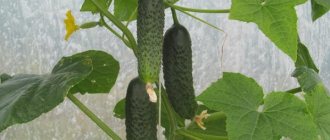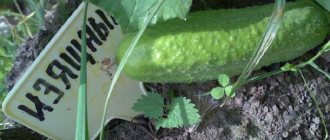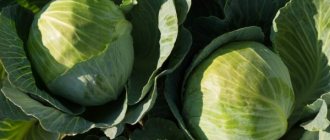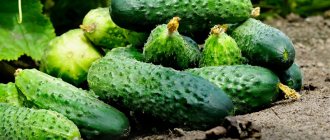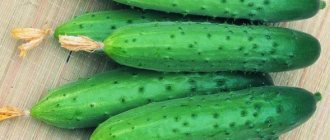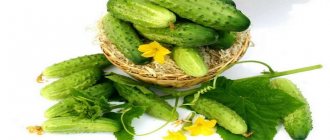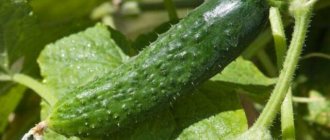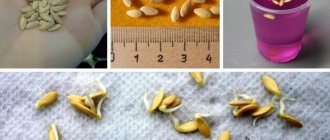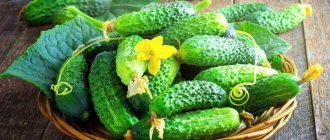Cucumber Caesar F1 was bred in Poland and belongs to the line of early ripening hybrids (medium early ripening). The cucumber is intended for active cultivation in open-air garden beds and in greenhouse conditions.
| Landing location | Ripening time | Mode of application | Fruit length | Group | Fruit smoothness | Pollination method |
| Universal | Mid-early (46-55 days) | Universal | Medium - from 10 to 15 cm | Hybrid | Highly lumpy | Bee pollinated |
Description of the variety
"Caesar" has a medium-early ripening period. From the moment of full germination to harvesting the first harvest, only 47-51 days pass.
Fruit:
- They have a leveled, cylindrical shape;
- Dark green in color, with longitudinal light stripes that cover up to 3/4 of the length of the greens;
- With a dense skin, covered with medium-sized tubercles, with sparse pubescence;
- With crispy, juicy, not bitter and not watery pulp;
- Dry matter content - about 4.5%;
- Sugar content - 2.3%;
- The amount of vitamin C is 13.9 mg/%;
- Length - from 10 to 12 cm;
- The average weight varies from 85 to 110 grams.
Bushes:
- Powerful, compact, vigorous, reaching a height of up to 150 cm;
- The leaves are medium-sized, dark green in color, with a matte surface, with smooth edges, in rare cases with wrinkled ones;
- Mainly with female type of flowering;
- In each leaf node, from 5 to 8 ovaries are formed at once.
Varieties of cucumbers starting with the letter c Caesar zircon gypsy
Articles Loading...
Despite the fact that the State Register contains a large number of different agricultural crops, varieties of cucumbers starting with the letter C occupy not the last place. Most of them belong to early varieties.
Description of cucumber varieties starting with the letter C
Features of early cucumber varieties
The description indicates that the early varieties are classified as first generation hybrids.
This is justified by the fact that such crops have an excellent immune system, which would protect the bushes from changes in spring temperatures and some dangerous diseases.
The ripening time for such varieties is 40-60 days from the moment the seeds are planted in open ground. The price of seeds of early varieties depends on the characteristics of a particular cucumber. On average, the cost of 1 pack of seeds is 21 rubles.
It is better to choose fertile chernozems, sandstones and loamy soils for planting. The acid-base balance of the soil should be no more than 6%, otherwise the root system will die and the yield will drop to 0.
Seeds should be planted in early May. By this time, the soil has already recovered sufficiently from winter frosts and has warmed up to the optimal temperature (10-13°C). If you are afraid that the plants will freeze, you can cover the rows of cucumbers with plastic wrap. They should be opened every day for a few hours to allow oxygen in and humidity levels to remain low.
Early varieties are considered universal. They can be used to prepare fresh salads, pickles or starters. High taste qualities are noted when consumed fresh. Their fruits are crispy and juicy.
Variety Caesar
Cucumber Caesar category F1 is characterized by early ripening. It is considered a product of Polish selection. Its growing season lasts 50 days from the moment the first shoots appear. The variety is self-pollinating. The plant is compact, up to 1.5 m high.
The leaves are medium in size, dark green in color, with a matte surface. The female type of flowering predominates. In 1 node, 5-8 ovaries can be formed at once, which significantly increases productivity.
This variety is resistant to diseases: brown spot, cucumber mosaic and powdery mildew.
The fruits are smooth, cylindrical in shape. The surface of the cucumbers is completely covered with small, dense black pinches. The peel is dense in structure.
On its surface you can see small thin stripes reaching to the middle. The length of 1 fruit is 10 cm, and the weight is about 100-120 g. During ripening, cucumbers do not overripe and do not crack. The taste is pleasant, sweet.
The pulp is juicy, but not watery. Bitterness is absent at the genetic level.
Planting work should be carried out in early May. It is allowed to grow the Great Caesar variety both in open ground and in greenhouse conditions. The planting pattern is 50x60 cm. The seeds of the f1 category hybrid need to be deepened by 3-4 cm. Harvesting begins at the end of June.
Hybrid species of Gypsy
The first generation Gypsy hybrid matures in a short period of time. Its growing season lasts for 50 days from the moment the seeds are planted in a permanent place. The plant is tall, about 3 m. This variety is characterized by parthenocarpicity and indeterminate bush. Flowering can be either female or male. The leaves are large, their color is dark green.
Several main characteristics should be highlighted:
- the yield is high, about 15 kg per 1 m2;
- the fruits are large, their length is about 12 cm;
- the weight of one cucumber is 130-150 g;
- the surface is wrinkled, with a large number of small bumps and dark spines, there are small light thin stripes reaching to the middle;
- the taste is pleasant, sweet, no bitterness observed;
- the flesh is crispy.
Seeds should be planted in late April or early May. Planting is possible both in open ground and in greenhouses. A distance of 40 cm should be maintained between rows, and 60 cm between bushes. Sowing depth is 4-5 cm. Products can be collected as early as mid-June.
Royal variety
The royal varieties of cucumbers are included in the State Register of the Russian Federation. They are recommended to be grown in garden plots.
This species has the characteristics of self-pollination and early maturation. The bush begins to bear fruit 45 days after the seeds begin to germinate. The plant is large, about 3 m in height.
The female type of flowering predominates. 4-6 ovaries are formed in each node.
The foliage is large. The leaves are dark green, pentagonal in shape. The description indicates resistance to powdery mildew, olive blight and root rot.
The fruits are large, their length can reach 15-17 cm. Weight 130-160 g. The shape of the fruit is cylindrical, the surface is smooth, without thorns or tubercles. The peel is thin, with a glossy surface. The pulp is juicy and crispy. Productivity is high: from 1 m2 you can harvest about 20 kg of high-quality products.
It is recommended to grow the crop indoors. Seeds are planted in early April. The planting pattern is 40x50 cm. The seeds are deepened by 4-6 cm. Already in early July you can harvest.
Information on the admission of Cucumber Zircon from the Register of the State Variety Commission of the Russian Federation
Application for admission No. 51951, registered 2008-12-26. The Cucumber Zircon variety was included in the register of those approved in 2011. Approved for use in the regions: North Caucasus.
The originator of the Cucumber Zircon variety is:
- NUNHEMS BV (PO BOX 4005 6080 AA HAELEN, NAPOLEONSWEG 152, 6083 AB NUNHEM, THE NETHERLANDS)
Advantages and disadvantages
Hybrid "Caesar" has the following positive qualities:
- High stable yield;
- Excellent taste characteristics;
- Friendly fruiting;
- Good presentation of greens;
- No tendency to overgrow and turn yellow;
- Inexpensive cost of seed material;
- Ability for long-term storage;
- Possibility of transportation over long distances;
- Unpretentiousness in care.
Among the disadvantages of "Caesar" are:
- Short fruiting period;
- Predisposition of fruits to barreling;
- The need for bees for pollination.
Agricultural technology or proper cultivation
"Caesar" is cultivated using seedless and seedling methods.
Growing seedlings:
- Seed material, after preparatory measures, is sown in March;
- Bury the seeds into the nutrient soil mixture by 1.5-2 cm;
- Throughout their growth, the seedlings must be watered with warm water from a spray bottle. It is also necessary to provide additional lighting to young shoots. Maintain the required temperature and apply fertilizers;
- If there are 2-3 full leaves and at the age of 2-3 weeks, the seedlings can be planted in separate pots;
- Before planting in a permanent place, cucumber seedlings should be hardened off;
- Cucumber bushes are planted according to a 90x15 cm pattern.
Seedless method:
- Direct sowing of seed material in unprotected soil is carried out no earlier than the end of April;
- Since cucumbers are heat-loving, the seeds are sown in soil heated to +14...+16 degrees. Otherwise, the seeds simply will not sprout;
- Both single-row and belt sowing methods are used. Seeds are buried 3-4 cm on light soils, 2-3 cm on heavy soils;
- The first time of planting should be covered with film.
The area for growing cucumbers should be well lit. They prefer medium-loamy, loose, low-acidity, humus-rich soil. It is advisable to use beds where corn, tomatoes, onions, cabbage, peas, and early potatoes grew a year earlier. It is not recommended to grow cucumbers after pumpkin crops.
The king of vegetable gardens from Polish breeders - Caesar F1 cucumber: description and reviews
Cucumber Caesar F1 was bred in Poland and belongs to the line of early ripening hybrids (medium early ripening). The cucumber is intended for active cultivation in open-air garden beds and in greenhouse conditions.
| Landing location | Ripening time | Mode of application | Fruit length | Group | Fruit smoothness | Pollination method |
| Universal | Mid-early (46-55 days) | Universal | Medium – from 10 to 15 cm | Hybrid | Highly lumpy | Bee pollinated |
Description and characteristics of the variety
Cucumber Caesar F1 forms ovaries with the participation of pollinating helpers bees.
What are the distinctive features of the hybrid:
- powerful bushes with good shoot-forming function (shaping required);
- pollination by bees;
- many female inflorescences.
It is recommended to harvest at the stage of greens 9-14 cm or gherkins 6-8 cm.
Polish cucumbers have the following characteristics:
- length 10-12 cm;
- weight 80-100 g;
- length to diameter ratio is 2.9 to 1;
- aligned cylindrical shape;
- consistency is strong, elastic;
- the pulp is crunchy, juicy;
- the taste is aromatic, with classic freshness and sweetness;
- dark coloring;
- light stripes to the middle.
The fruits are used universally. In summer and autumn they are cut into fresh salads; in winter and spring they are used as canned and pickled cucumbers.
Taste assessment from experts
- fresh - 4.6-5 points
- lightly salted, canned - 5 points.
Pros:
- friendly uniform fruiting;
- stable productivity;
- presentable presentation;
- excellent taste;
- tolerance to temperature fluctuations;
- precocity;
- transportability and keeping quality;
- resistance to a complex of cucumber infections.
Minuses:
- when overgrown, the fruits may barrel;
- short fruiting period in comparison with other early hybrids.
Productivity
Cucumber Caesar F1 brings massive harvests - 5-6.7 kg are harvested from 1 plant.
Landing
Before sowing, the seeds are disinfected in 1% potassium permanganate and soaked for 5-6 hours in an infusion of ash. Then they are transferred to moistened cotton cloth and kept in a sunny window. For planting, use a nutritious soil mixture, light and loose, intended for cucumber crops.
How to plant and care:
- sow to a depth of 2 cm;
- the surface is lightly compacted;
- before germination of seedlings, cover with polyethylene;
- maintain the regime - temperature 25-27 degrees and humidity within 90%;
- irrigate with settled water through a spray bottle;
- When 1-2 leaves grow, water with nitroammophoska or Agricola.
The bushes are transplanted into beds upon reaching 28-32 days. Harden in advance for 10 days.
Direct sowing on a plot is carried out when the soil warms up to 12 degrees.
The placement schemes are followed:
- 2-3 plants per 1 m2;
- the distance between holes in a row is 30-35 cm;
- row spacing 70 cm.
Growing and care
When planting a hybrid in covered areas, the harvest is harvested 3 times a year. The cucumber is undemanding and bears fruit well with a standard set of agrotechnical procedures:
- Installation of trellises and supporting structures. Regular fixation of growing lashes.
- Watering is systematic, taking into account the stage and weather. The frequency varies from 3 to 6 times per week. The liquid rate is within 3-4 liters per 1 bush.
- Application of fertilizers. Up to 5 feedings are required per season. The Mullein composition with the addition of ash and droppings is effective. Be sure to fertilize with phosphorus-potassium mixtures and complexes.
- Formation. Rapidly growing shoots become blind after the 4th leaf (lateral lashes).
Diseases and pests
Cucumber Caesar F1 has strong immunity to such diseases
Infections may include:
| Name | Symptoms |
| Cladosporium | Black or grayish spotsStopping the growth of greens |
| Downy mildew | Death of bushes Tastelessness of cucumbers |
Cucumber Caesar F1 is a hybrid that has earned recognition from farmers in Poland and Russia. Among the bonuses are excellent taste and canning properties, significant productivity. This cucumber is quite promising for cultivation in different climatic regions due to its adaptability.
Source: https://repka.online/ovoshhi/ogurtsyi/sredneranni/tsezar-f1.html
Care
Despite the unpretentiousness of the hybrid, the following care measures will be required:
- Water the plantings regularly with warm, settled water. Until the plant begins to bloom, watering is carried out once a week. During the flowering and fruiting period, water 3-4 times a week. When growing in a greenhouse, after irrigation, be sure to ventilate the structure;
Experienced gardeners recommend using a drip irrigation system.
- During the growing season, fertilizing is carried out 3-4 times. Due to their rapid growth, cucumbers require a lot of nutrients. At the beginning of the growing season, plants are fed with fertilizers enriched with nitrogen; during the formation of vines, potassium fertilizers are needed;
- The hybrid is grown on trellises;
- The formation of a bush is carried out in one stem. After the formation of 6-7 leaves, pinch the cucumber top;
- Also, loosening and weeding should not be neglected;
- Carry out preventive spraying to prevent the appearance of pests and diseases.
